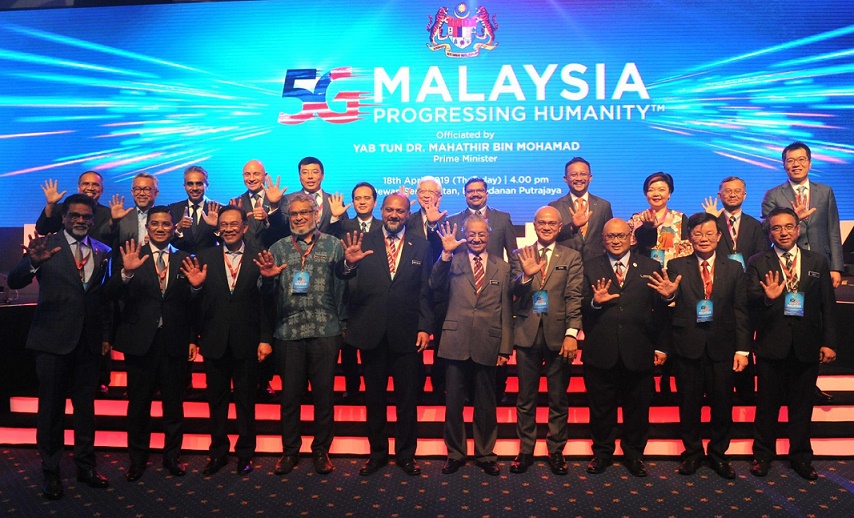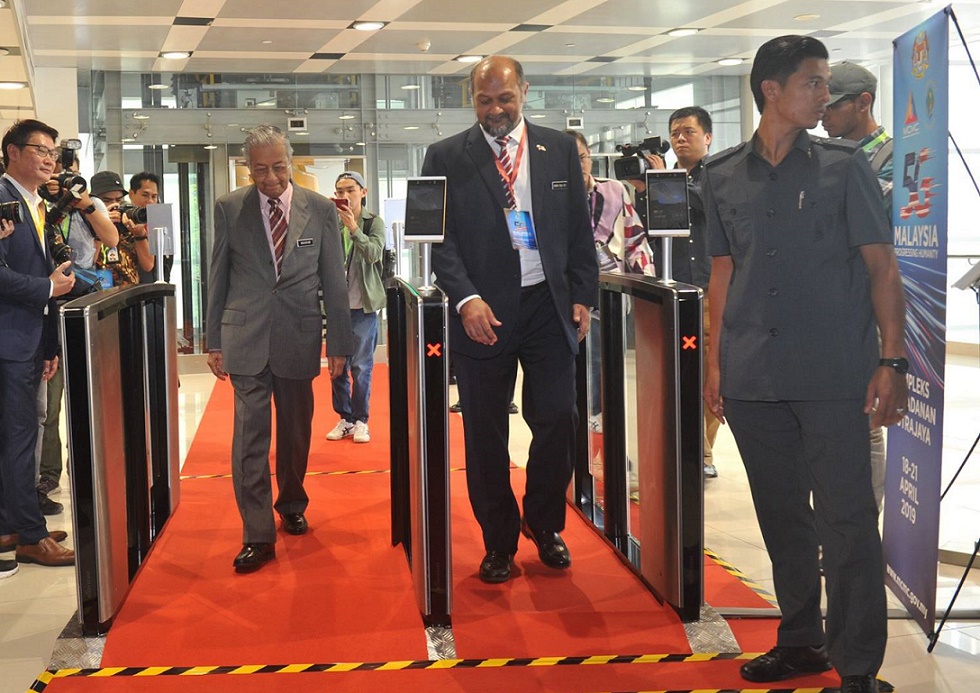Mahathir hopes 5G will boost wages, productivity, address inequality
By Tan Jee Yee April 19, 2019
- Understanding of technology among students has to be emphasised and promoted now
- PM aims for nation to be in Top 30 of Global Innovation Index by 2025 from current 35

AT the launch of the 5G Malaysia Showcase on April 18, Prime Minister Dr Mahathir Mohamad, and Communications and Multimedia Minister Gobind Singh Deo arrived in an autonomous car. It drove, steadily enough, to the entrance of the Kompleks Perbadanan Putrajaya building, its short journey captured by drones that broadcast the video to the audience waiting in the event hall.
Midway through his walk across the showroom floor, the premier stopped to access the facial recognition technology on automated turnstiles. After his speech, Mahathir was greeted by a hologram of “Adik Aishah”, the little girl best known for her appearance in a video with the prime minister. They had a brief (albeit scripted) conversation.
It’s apt, perhaps, for Mahathir to literally walk the audience through 5G’s capabilities, he himself having initiated the Multimedia Super Corridor (MSC) that kickstarted Malaysia’s digital journey in 1996. Indeed, the 5G Malaysia Showcase is a window to a Malaysia with 5G connectivity as its backbone.
“Indeed, 5G marks an inflection point in the future of communications, taking us into a dimension which is some time beyond our imagination,” Mahathir said in his address. What is not beyond imnagination is for the country to leverage on 5G and move up the rankings as an innovation focused nation. With this Mahathir shares that, "the aim is for the country to be in the Top 30 of the Global Innovation Index by the year 2025."
The Global Innovation Index is an annual ranking of countries by their capacity for, and success in, innovation. It is published by Cornell University, Insead, and the World Intellectual Property Organization, in partnership with other organisations and institutions. Malaysia ranked 35 in 2018, moving up two spots from 2017. Among upper middle income countries, it ranked second, behind China which ranked 17 overall.
Putting 5G in the forefront
The 5G Malaysia Showcase is an opportunity for Malaysians to experience the benefits of 5G technology and how it can impact their lives. Held in Putrajaya from April 18 to April 21, with April 19 set aside for bureaucrats while April 20 & 21 are open to the public where visitors will be able to witness various 5G tech demonstrations, and even try some out for themselves.
It’s akin to dipping one’s toes in before the inevitable plunge into 5G’s waters. Mahathir noted, that if Malaysia is to enter the Fourth Industrial Revolution, 5G will be the vital bridge that allows our crossing.
“The Fourth Industrial Revolution melds advances in the digital, physical and biological spheres, and brings with it breakthroughs in artificial intelligence, robotics, big data, virtual reality and software engineering,” he said.
“One of the key elements to enable and usher in this new age is advanced mobile wireless technology. By and large, the earlier generations of mobile connectivity enabled people-to-people communications, with some capabilities for different scenarios. 5G on the other hand, offers much more than just speed.”
The transition from 4G to 5G, he adds, won’t be instantaneous. “It requires significant effort in research and development, industry collaboration, and the resources necessary to support that effort. I am glad to state that the Government has embarked on the National Fiberisation and Connectivity Plan (NFCP) to ensure the readiness and timely deployment of 5G technology.”

Bridging gaps
The premier says that 5G will impact every industry that is vital to the growth of the country’s economy, especially in the manufacturing sector.
“About 98.5% of Malaysian companies are SMEs and of this, 5.3% or 47,698 companies [Source: SME Corp's 2017/2018 Annual Report] are in the manufacturing sector. It is the manufacturing sector that allows Malaysia to consistently demonstrate the dynamism and resilience needed to grow, while attracting foreign direct investments,” he explained.
“Through smart manufacturing or massive machine-type communications, the Government hopes that it can attract high value-added, high technology and knowledge-intensive investment in areas such as aerospace, chemicals and chemical products, machinery and equipment, medical devices, and in the electrical and electronics sector.”
Continuing, Mahathir said that there is a need to address the growing income inequality in the country, citing Khazanah Research Institute studies that show that Malaysia’s income gap has doubled in two decades.
“These gaps in inequality, if left unchecked, will affect economic and social growth in the long run. Inequality can threaten sustainable growth if it leads to under-privileged health problems, poor productivity; as well as low education levels,” he warns.
On this note, Mahathir believes that technology can ensure the efficacy of businesses, which in turn can yield an increase in productivity and output as well as worker wages.
5G, he adds, can guarantee quality education is spread widely across the country, “connecting the unconnected in the rural areas.” With better connectivity, teaching can move beyond the classroom while students can gain access to different and more interactive ways of learning.
“With the Fourth Industrial Revolution already upon us, it has become more crucial than ever to develop essential skills among young Malaysians, which requires not only data-driven skills, but also mental agility, particularly when disruption has become the norm in our everyday lives.
“Education, and the understanding of technology among the students cannot wait. It has to be emphasised and promoted now,” he insisted.
A glimpse of a 5G future
Visitors to the 5G Malaysia Showcase will be witness to a multitude of 5G-related technology. They can interact with robots, observe the use of holograms and learn about artificial intelligence, on top of checking out the latest technologies in facial recognition, 3D printing, drone simulation and crowd tracking systems.
“Our daily life in the future will be made more convenient and more efficient - enhanced and enabled by 5G connectivity,” said Gobind in his speech.
“We are talking of farmers being able to detect soil moisture and acidity in real time to maximise their yield and efficiency and fishermen being able to maximise their yield by precision techniques. We are looking at the police or firefighters substantially reducing risk to their lives whilst still being able to provide quick and precise responses through robotics empowered by 5G. These are just a few examples of what will be possible in future with 5G.”
During the press conference, the minister reiterated that a 5G testbed is being prepared by Malaysian Communications & Multimedia Commission (MCMC), with trials set to run from April to October. By the end of the year, a final report of the testbed will be presented to the government.
After the trials have concluded, Gobind says they will be able to ascertain the sectors and areas in which to prioritise 5G deployment. For now, he says that the testbed is to prepare the country for the challenges of implementing 5G in the near future.
Related Stories :


